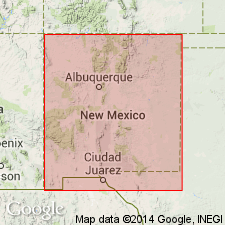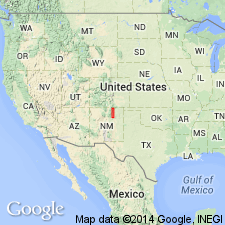
- Usage in publication:
-
- Tres Lagunas Member
- Modifications:
-
- Named
- Dominant lithology:
-
- Conglomerate
- Sandstone
- AAPG geologic province:
-
- Palo Duro basin
Summary:
Named the upper member of three newly named members of Santa Rosa Formation for Tres Lagunas, north of Santa Rosa, Guadalupe Co, NM in Palo Duro basin. Name replaces upper sandstone member of Santa Rosa. Type section measured in N1/2 NE1/4 Se1/4 sec 36, T9N, R21E where it is 7 m thick, and it disconformably overlies Los Esteros Member (new) of Santa Rosa; it underlies Chinle Formation. Consists at type of basal light-gray (fresh), dusky, yellowish-brown (weathered) medium-grained, moderately well sorted, very calcareous conglomerate with clasts of micritic limestone as much as 10 cm long in a quartz arenite matrix that is overlain by salt-and-pepper (fresh), pale-orange to brown (weathered), medium-grained, well-sorted, well-rounded sandstone. Sandstone beds are slightly calcareous and have planar crossbeds. Maximum thickness is 46 m. Extends eastward into subsurface of Quay and Curry Cos; wedges out just east of Clovis, Curry Co, NM. Correlated with Moss Back Member, Chinle and middle part of Tecovas Formation. Of late Carnian, Late Triassic age. Nomenclature charts.
Source: GNU records (USGS DDS-6; Denver GNULEX).

- Usage in publication:
-
- Tres Lagunas Member
- Modifications:
-
- Areal extent
- AAPG geologic province:
-
- Las Vegas-Raton basin
- Palo Duro basin
Summary:
The three members of the Santa Rosa Formation--the basal Tecolotito; middle or Los Esteros; and the upper, Tres Lagunas--can be recognized as far north as La Cueva, Mora Co, NM, Las Vegas-Raton basin. North of La Cueva, only the Tecolotito Member is thought to be present, and the Los Esteros and Tres Lagunas have pinched out. Correlation chart. Cross section. Identified in measured sections at Montezuma Gap and San Sebastian Canyon, San Miguel Co, Palo Duro basin, and at La Cueva, Mora Co. Many previous workers have used Santa Rosa Sandstone in report area; few place the lower and upper contacts at the same horizon. Of Late Triassic, Carnian age.
Source: GNU records (USGS DDS-6; Denver GNULEX).
For more information, please contact Nancy Stamm, Geologic Names Committee Secretary.
Asterisk (*) indicates published by U.S. Geological Survey authors.
"No current usage" (†) implies that a name has been abandoned or has fallen into disuse. Former usage and, if known, replacement name given in parentheses ( ).
Slash (/) indicates name conflicts with nomenclatural guidelines (CSN, 1933; ACSN, 1961, 1970; NACSN, 1983, 2005, 2021). May be explained within brackets ([ ]).

